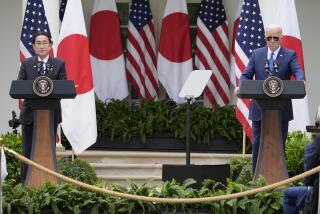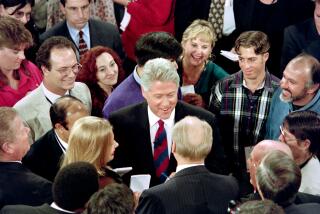Clinton May Be Chasing Chimera in Japan--Again
- Share via
TOKYO — Each of the three times President Clinton has visited Japan, he has come with different priorities and a different image of the country.
In 1993, he came here on his first overseas trip to try to deal with Japan the Powerhouse. In early 1996, the president flew here to cultivate Japan the Military Partner. Now he’s trying to rejuvenate Japan the Sluggard.
On those two earlier trips, Clinton achieved only a portion of what he wanted--largely because Japan did not easily fit the images Americans held of it. And the president may well discover that to be true on this visit too.
“In 1998, the administration still has not really identified what its priorities are for Japan,” says Kent Harrington, a former senior CIA official specializing in Japan. “On each of his visits, Clinton came with an image in his mind that didn’t fit the reality. The administration has dealt with only the parts of the [U.S.-Japanese] relationship, not the whole.”
The story of Clinton’s three trips to Japan encapsulates not only how U.S. policy toward Asia has evolved in the 1990s, but also how the United States itself has changed.
At the beginning of the decade, the United States was worried about its own lagging economy and its ability to compete in international markets. In the middle of the decade, Washington was preoccupied with the security implications of China’s growing power.
Now the U.S. economy and Washington’s relationship with China have improved, and the Clinton administration is concerned above all about averting a global economic slump.
Here is how Clinton’s approach to Japan has evolved over the past half-decade.
1993: The Powerhouse
When Clinton flew to Tokyo in July 1993, the visit was seen as his first test as a world leader. The new president was so unsure of himself that he allowed the trip to be orchestrated by a new White House advisor, David Gergen, a Republican public-relations specialist.
“Don’t forget to bring your tuxedo, Mr. President,” Gergen told Clinton before the trip, recalling the gaffe President Gerald Ford once committed in Japan by wearing a borrowed tuxedo with pants that were a foot short.
At the time, Japan’s economy was already in the early stages of a long slump that still persists. The bubble had burst in Japan’s stock and real estate markets.
Yet the lingering U.S. images of Japan as economic behemoth--a perception that had sparked the late-1980s jitters that Japan might buy Hollywood, Washington and Wall Street--were the ones that dominated that inaugural trip.
When Clinton first arrived in the White House, his administration’s approach to Japan was largely confrontational. Soon after he took office, Clinton sought to pressure Japan to reduce its massive trade surplus with the United States.
“Let’s not paper this over,” Clinton had told Japanese Prime Minister Kiichi Miyazawa about the trade dispute when the two men met in Washington in April 1993.
In Tokyo that July, Clinton and Miyazawa worked out a trade accord aimed at setting out new economic “rules of the game” between the United States and Japan.
“Today’s agreement is an important step toward a more balanced trade relationship between the United States and Japan,” Clinton said at the time.
It has not worked out that way. The U.S. trade deficit with Japan was $50 billion back then. It will probably be more than $60 billion this year.
In fact, within a year after that 1993 trip, the administration had shifted its focus. With the United States’ own economy improving, the political pressure was off. Then-U.S. Trade Representative Mickey Kantor began telling reporters that the trade figures did not matter so much.
Clinton’s 1993 trip was not entirely a failure. In a speech Clinton gave at Waseda University, he raised some interesting themes the Japanese had not heard from an American president: that Japanese consumers were being harmed by the high prices and restrictive trade practices of Japanese companies.
That line of argument put Clinton ahead of the curve in Japanese politics. Only a few weeks later, Japanese voters for the first time threw the dominant Liberal Democratic Party out of office and ushered in a new leader, Prime Minister Morihiro Hosokawa, who favored consumerism and deregulation of the Japanese economy.
Hosokawa, for whom the administration held high hopes, lasted less than a year.
At the end of Clinton’s first visit here, Lawrence Summers, then undersecretary of the Treasury, proclaimed that the U.S. had won a commitment from Japan to cut its overall surplus with the world to less than 2% of its gross domestic product within four or five years.
At a White House briefing a few days ago, Summers acknowledged that Japan’s surplus “will exceed 3% of GDP in 1998 and 1999.”
1996: The Partner
Clinton returned to Tokyo in April 1996, the month after China fired a series of missiles into waters off nearby Taiwan to show its irritation with Taipei’s first direct presidential election.
The Chinese display of military power rattled other Asian governments. So Clinton used his second visit to Japan to reassure the region of Washington’s military presence. He visited the flight deck of the aircraft carrier Independence in Tokyo Bay and praised the American sailors who had been sent near Taiwan at the height of the China crisis.
“Without firing a single shot, you reassured nations all around the Pacific,” Clinton said.
Clinton and Prime Minister Ryutaro Hashimoto solidified and extended the military alliance between the two countries. That alliance had been formed during the Cold War, but in 1996 it was reshaped to make Japan a military partner with the United States--not to defend against the Soviet Union, but to protect the future security of Asia.
China was outraged by these signs of a new U.S.-Japanese partnership. And in retrospect, the tumultuous events of 1996 spurred China and the administration to become more conciliatory--culminating in Clinton’s milestone trip to Beijing last summer.
Looking back, some Japanese now wonder if they were being used.
“Some [in Japan] suspect that the United States enhanced its security ties with Japan in 1996 expressly to strengthen its negotiating position with China,” Japanese commentator Yoichi Funabashi wrote recently in Foreign Affairs magazine.
Although the renewal of the U.S.-Japanese military alliance was important, it has not yet fulfilled the administration’s hopes.
To the dismay of Pentagon officials, the Japanese parliament has not yet given approval to the detailed guidelines spelling out how Japan will cooperate with the U.S. military--specifying, for example, when and how American troops can use Japanese facilities.
“Once the United States gets into [a] war situation, I’m afraid that Japan might be sort of pulled into that also,” one Japanese woman bluntly told Clinton at a town hall meeting here Thursday.
1998: The Sluggard
Now Clinton has come to Tokyo worrying once again about the Japanese economy, but in a different way. The fear is not that Japan is too strong, but that it is too weak.
Japan’s economy “is . . . the second-largest economy in the world, but it has been stalled for five years,” Clinton remarked as he was leaving for Tokyo.
The administration’s emphasis is no longer on getting Japan to buy more U.S. products, but rather on getting Japan to stimulate its economy so that the Japanese will buy more from other Asian nations.
But the president may well be frustrated once again, because Japan’s economic slump may not be dire enough to galvanize the country to change as much as the United States would like.
Clinton appears to have been sobered by his experiences with Japan over the past five years. Speaking to a Japanese audience at the town hall meeting Thursday, Clinton mused: “The challenges Japan has today will not be solved overnight.”
More to Read
Get the L.A. Times Politics newsletter
Deeply reported insights into legislation, politics and policy from Sacramento, Washington and beyond. In your inbox twice per week.
You may occasionally receive promotional content from the Los Angeles Times.








